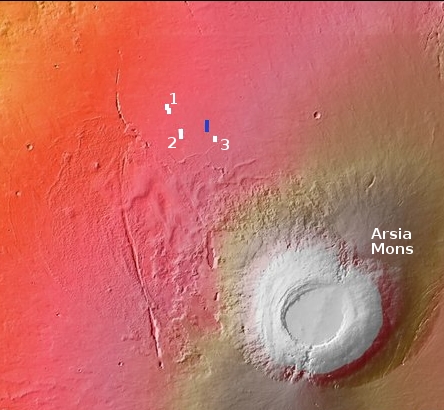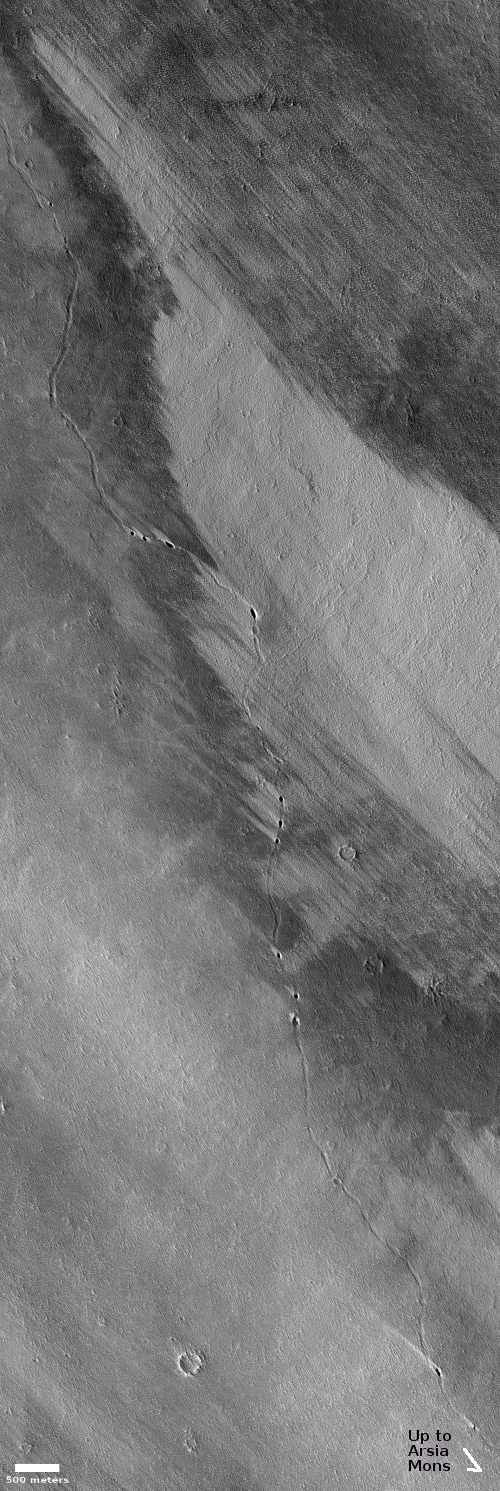The longest lava tube in the solar system?
Before I delve into today’s cool image, I think it important to explain to my readers why I seem to post so many cool images from Mars. The simple explanation is that Mars right now is where almost all the cutting edge planetary research is taking place, and as a science journalist focused on space exploration I must go to that cutting edge. My dear readers know that I love variety (just consider the evening pauses on Behind the Black), but you can’t ignore the reporting of real discoveries simply to increase the diversity of one’s posts. This is too often what modern news outlets do, which is also why they often miss the real story.
Anyway, today’s cool image to the right, rotated, cropped, and reduced to post here, shows only a small section of what might be the longest lava tube in the entire solar system. Taken on May 5, 2020 by the high resolution camera on Mars Reconnaissance Orbiter (MRO), it shows a string of pits along a meandering depression coming down the northwest flank of the giant volcano Arsia Mons. The image was a follow-up to a July 2014 photo of the same location, and was taken to produce a stereo pair.
The feature strongly suggests a lava tube, with the pits being skylights into the meandering underground void. From top to bottom this section of the tube is a little over three miles long. Since there are lava tubes on Earth far longer, this one image hardly makes this the longest tube in the solar system.
The tube, however, extends off the image both at the bottom and at the top. Not many high resolution images have been taken in this area, so it is therefore hard to say how far the tube extends. Other nearby high resolution images in this area however have found similar lava tubes, which conceivably could be part of the same tube. The overview map below shows the relationship.

The blue rectangle indicates the location of the photo above. The overlapping white rectangles numbered one indicate the location of two other lava tube images, each discussed at these posts:
- January 19, 2019: The many pits/caves of Mars
- May 7, 2019: The many pits of Arsia Mons
The white box numbered two is another image showing a similar trending depression, though in that case there are no visible skylights. Number three however is another lava tube with skylights, higher up the mountain.
In every image the trend of the tubes or depressions is the same, downhill from the southeast to the northwest. In every image the prevailing winds blow in about the same direction, coming down the mountain’s slope. Excluding #2, which is slightly off line, all the other tubes align nicely and might very well be parts of the same tube.
Finally, the depressions and skylights appear to get larger as you go up the mountain, something entirely to be expected.
With the rim of Arsia Mons about 280 miles away from lava tube #1, and about 40,000 feet higher, this tube has the potential to be many times longer and deeper than the longest and deepest lava tube on Earth, Kazumura Cave in Hawaii, which is just under 41 miles long with a depth of 3,613 feet. And since these giant volcanoes on Mars are by far the largest so far found anywhere in the solar system, this tube could easily be the largest for many light years.
Its underground cross-section could be also be much bigger, due to Mars’ lower gravity. And though there is almost no evidence of shallow ice here near the equator, there still is evidence both of past glacial activity on the slopes of Arsia Mons as well as seasonal water clouds overhead. These lava tubes might therefore still have ice in them, and thus provide a potential future colony site.
On Christmas Eve 1968 three Americans became the first humans to visit another world. What they did to celebrate was unexpected and profound, and will be remembered throughout all human history. Genesis: the Story of Apollo 8, Robert Zimmerman's classic history of humanity's first journey to another world, tells that story, and it is now available as both an ebook and an audiobook, both with a foreword by Valerie Anders and a new introduction by Robert Zimmerman.
The print edition can be purchased at Amazon or from any other book seller. If you want an autographed copy the price is $60 for the hardback and $45 for the paperback, plus $8 shipping for each. Go here for purchasing details. The ebook is available everywhere for $5.99 (before discount) at amazon, or direct from my ebook publisher, ebookit. If you buy it from ebookit you don't support the big tech companies and the author gets a bigger cut much sooner.
The audiobook is also available at all these vendors, and is also free with a 30-day trial membership to Audible.
"Not simply about one mission, [Genesis] is also the history of America's quest for the moon... Zimmerman has done a masterful job of tying disparate events together into a solid account of one of America's greatest human triumphs."--San Antonio Express-News
Before I delve into today’s cool image, I think it important to explain to my readers why I seem to post so many cool images from Mars. The simple explanation is that Mars right now is where almost all the cutting edge planetary research is taking place, and as a science journalist focused on space exploration I must go to that cutting edge. My dear readers know that I love variety (just consider the evening pauses on Behind the Black), but you can’t ignore the reporting of real discoveries simply to increase the diversity of one’s posts. This is too often what modern news outlets do, which is also why they often miss the real story.
Anyway, today’s cool image to the right, rotated, cropped, and reduced to post here, shows only a small section of what might be the longest lava tube in the entire solar system. Taken on May 5, 2020 by the high resolution camera on Mars Reconnaissance Orbiter (MRO), it shows a string of pits along a meandering depression coming down the northwest flank of the giant volcano Arsia Mons. The image was a follow-up to a July 2014 photo of the same location, and was taken to produce a stereo pair.
The feature strongly suggests a lava tube, with the pits being skylights into the meandering underground void. From top to bottom this section of the tube is a little over three miles long. Since there are lava tubes on Earth far longer, this one image hardly makes this the longest tube in the solar system.
The tube, however, extends off the image both at the bottom and at the top. Not many high resolution images have been taken in this area, so it is therefore hard to say how far the tube extends. Other nearby high resolution images in this area however have found similar lava tubes, which conceivably could be part of the same tube. The overview map below shows the relationship.

The blue rectangle indicates the location of the photo above. The overlapping white rectangles numbered one indicate the location of two other lava tube images, each discussed at these posts:
- January 19, 2019: The many pits/caves of Mars
- May 7, 2019: The many pits of Arsia Mons
The white box numbered two is another image showing a similar trending depression, though in that case there are no visible skylights. Number three however is another lava tube with skylights, higher up the mountain.
In every image the trend of the tubes or depressions is the same, downhill from the southeast to the northwest. In every image the prevailing winds blow in about the same direction, coming down the mountain’s slope. Excluding #2, which is slightly off line, all the other tubes align nicely and might very well be parts of the same tube.
Finally, the depressions and skylights appear to get larger as you go up the mountain, something entirely to be expected.
With the rim of Arsia Mons about 280 miles away from lava tube #1, and about 40,000 feet higher, this tube has the potential to be many times longer and deeper than the longest and deepest lava tube on Earth, Kazumura Cave in Hawaii, which is just under 41 miles long with a depth of 3,613 feet. And since these giant volcanoes on Mars are by far the largest so far found anywhere in the solar system, this tube could easily be the largest for many light years.
Its underground cross-section could be also be much bigger, due to Mars’ lower gravity. And though there is almost no evidence of shallow ice here near the equator, there still is evidence both of past glacial activity on the slopes of Arsia Mons as well as seasonal water clouds overhead. These lava tubes might therefore still have ice in them, and thus provide a potential future colony site.
On Christmas Eve 1968 three Americans became the first humans to visit another world. What they did to celebrate was unexpected and profound, and will be remembered throughout all human history. Genesis: the Story of Apollo 8, Robert Zimmerman's classic history of humanity's first journey to another world, tells that story, and it is now available as both an ebook and an audiobook, both with a foreword by Valerie Anders and a new introduction by Robert Zimmerman.
The print edition can be purchased at Amazon or from any other book seller. If you want an autographed copy the price is $60 for the hardback and $45 for the paperback, plus $8 shipping for each. Go here for purchasing details. The ebook is available everywhere for $5.99 (before discount) at amazon, or direct from my ebook publisher, ebookit. If you buy it from ebookit you don't support the big tech companies and the author gets a bigger cut much sooner.
The audiobook is also available at all these vendors, and is also free with a 30-day trial membership to Audible.
"Not simply about one mission, [Genesis] is also the history of America's quest for the moon... Zimmerman has done a masterful job of tying disparate events together into a solid account of one of America's greatest human triumphs."--San Antonio Express-News



Robert, please don‘t apologise for posting these images! Sure, sometimes I scroll past one & say ho-hum, but most are gems! Keep ‘em coming!
David M. Cook: That wasn’t meant as an apology, merely an explanation why so many of these images are from Mars.
Either way, shame on you for thinking ANY of my cool images are “ho-hum!” They are all gems, you simply need to look harder. That is an order! (I’m trying to get with the program of controlling what everyone does. It’s the IN thing, I hear.)
Lava tube inhabitants can be harmful to the incoming Pioneers, especially at night.
Meanwhile, what very cool camp sites lurk there under ?